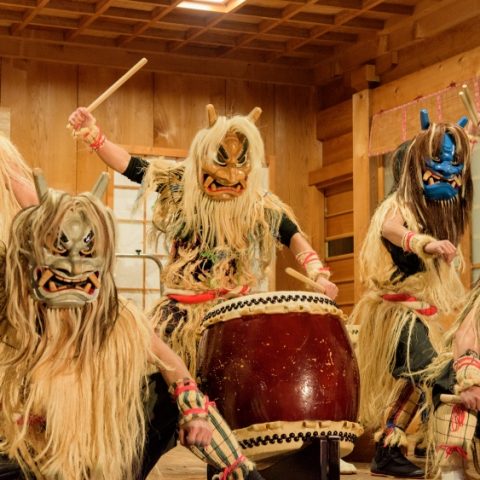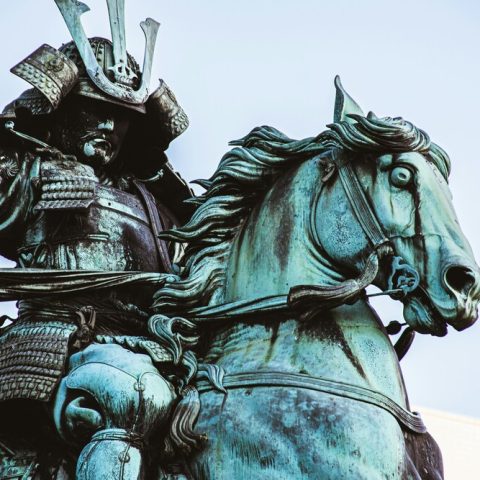
What do you usually do on New Year’s in your country? In Japan, we often go to ‘Hatsumode’. Hatsumode is a tradition where people go to a shrine or temple at the beginning of the year to pray for happiness in the coming year.
What is Hastumode?
One of the originally attributed customs of Hatsumode is called ‘Toshigomori.’ Toshigomori is the culture where the head of a village or household stays at a local shrine or temple from New Year’s Eve through to New Year’s morning without sleeping.
The tradition of Toshigomori has faded in Japan, but it is divided into two separate visits such as on New Year’s Eve (Joyamode) and on New Year’s morning (Gantanmode). Gantanmode became the modern Hatsumode, but the significant difference is that there used to be specific rules about which shrine or temple to visit based on the direction of Eho.

Hatsumode Credit: にっしーな
In some regions, the tradition of visiting a shrine or temple twice, on New Year’s Eve and New Year’s morning still exists. However, in most areas, it has become common to visit freely, without specific rules, particularly on New Year’s morning.
Interestingly, the changes in tradition were due to the development of transportation networks. It allowed people to easily visit not only local shrines or temples but also famous ones located far away. In my opinion, while it’s sad to see some cultural traditions fade, it’s also wonderful to see them evolve, and still be beloved.

Offering Box Credit: LU XISH
What to do at Hatsumode?
Do you know the correct way to perform Hatsumode? Here’s the step-by-step process:
- Purify Your Hands and Mouth
Firstly, there is a holy fountain called “Chozuya”, so take the ladle with your right hand and use it to wash your left hand. Then, switch the ladle to your left hand and wash your right hand. Afterward, switch the ladle back to your right hand again and pour water in your cupped left hand to rinse your mouth. Be sure not to drink water and touch the ladle with your mouth. Once again, wash your left hand. Finally, put the ladle back down and clean it by trickling water over it before putting it back to where it was. - Offering Old amulets
Next, dedicate old amulets that you bought in the past year. These can be burned at the shrine. When carrying them, people usually wrap them in white paper or washi (traditional Japanese paper). However, for your first Hatsumode experience, you can skip this process and go to step. - Praying at the Main Hall
When you arrive at the main hall, you should throw money into the offertory box and then ring the bell. In a shrine, there is an important rule for your Hatsumode visit such as bow twice, clap your hands twice, put your hands together to pray, and conclude with one final bow.
If you are visiting a temple, most of the rules are similar to those at a shrine. However, instead of clapping your hands and bowing twice, you should put your hands together, quietly offer your prayers, and bow once before and after praying.

Omikuji Credit: Daniel Gregoire
Once you’ve completed your prayers, your Hatsumode is concluded. Afterward, you can buy amulets, omikuji (a paper fortune), and get a red ink stamp. Additionally, there are two important points to keep in mind during Hatsumode. First, when throwing money, it’s respectful to avoid using 1-yen coins. Secondly, after you’ve drawn an omikuji, follow the shrine’s rules by either tying it to a designated area or taking it home with you.
Where To Go?

Meiji Jingu Credit: TOKYO DATE
Meiji Jingu Shrine
When you exit the west side of JR Harajuku Station in Shibuya, Tokyo, you’ll see a torii gate right in front of you. It is the Meiji Shrine, which is known for recording the highest number of Hatsumode visitors in Japan every year. Meiji Shrine enshrines Emperor Meiji and Empress Dowager Shoken, and it is said that they had a close relationship. As a result, the shrine is believed to offer blessings for love and marriage, success in exams, and thriving businesses.
Address: https://maps.app.goo.gl/afsRkron2SxyL3828
Website: https://www.meijijingu.or.jp/en/

Naritasan Shinshoji Temple Credit: クッキー
Naritasan Shinshoji Temple
Naritasan Shinshoji Temple, located in Narita City, Chiba Prefecture, is the most famous temple in the Kanto region. From Narita Station to the entrance of Shinshoji Temple, there is a historic street with beautiful buildings. This street is famous for its eel dishes, so it’s a great opportunity to try Japanese eel on New Years. At Naritasan Shinshoji temple, the main hall enshrines Fudo Myoo and is believed to provide blessings for various aspects of life, including warding off misfortune, promoting good luck, ensuring good health and longevity, thriving businesses, and academic success.
Furthermore, there are special amulets available only during the New Year period, but they are limited in quantity, so it’s recommended to get them as souvenirs before they run out.
Address: https://maps.app.goo.gl/MZ1yZ9Sh5mJhptNY6
Website: https://www.naritasan.or.jp/english/

Sensoji Temple in a Kimono for New Year Credit: Chisato Takahashi
Senso-ji Temple
If you are good at cold weather, I highly recommend visiting Tokyo’s oldest temple, Sensoji, located in Asakusa. Sensoji Temple is believed to bring blessings for various wishes, including success in exams and thriving businesses, love, and marriage. During the three days from New Year’s Eve to the third day of the year, approximately 2.8 million people visit. This accounts for about 10% of the total annual visitors, which is around 30 million. As a result, some people avoid visiting during the New Year due to the crowds. However, I encourage everyone to try it, because accessing kimono rental shops in Asakusa is very convenient, allowing you to celebrate the new year in traditional Japanese dress. I’ve also had the opportunity to visit Sensoji Temple in a kimono for New Year, and it was a fantastic experience with food stands. Just remember to dress warmly underneath the kimono to stay comfortable in the cold.
Address: https://maps.app.goo.gl/noyDZjLVjyjurvoHA
Website: https://www.senso-ji.jp/english/

The Biggest Ema in Kyoto Credit: ささやか
Matsunoo Taisha Shrine
The next one is Matsunoo Taisha in Kyoto. Matsunoo Taisha is known for displaying the largest ema (wooden votive picture) in Kyoto and is one of the city’s oldest shrines, making it a perfect spot for Instagram. Visitors can receive a smaller version of the ema and Japanese sake due to the strong faith of sake brewers. The shrine is famous for its Nadegame (turtle stroking) and Souri (koi fish), believed to bring blessings of health, longevity, domestic harmony, romantic success, career advancement, and marital bliss. While the way to the main hall may be a bit crowded, you can still have a fantastic New Year celebration with delicious Japanese sake and ema souvenirs.
Address: https://maps.app.goo.gl/vRJCvCdjyZvyPaDx7
Website: https://www.matsunoo.or.jp/

Thousands of Inari Fox Statues Credit: えいの旅
Toyokawa Inari
Next, let me introduce you to Toyokawa Inari located in Toyokawa City, Aichi Prefecture, which is known as the god of thriving businesses and has branch temples across the country. This temple follows the Soto sect, so the process of praying is different from a regular temple visit. If you are interested in trying the formal method and have confidence in your Japanese language skills, I recommend preparing in advance. Here’s the procedure :
- Wash your hands, rinse your mouth, and straighten your clothing while maintaining a proper posture.
- Put your hands together, and speak “Kimyou Chourai Toyokawa Dakini Shin Ten” 3 times.
- Then “On Shira Battani Riun Sowa ka” 21 times (7 times is also acceptable).
- Put your hands together and quietly offer your prayers.
- Repeat step 2 to conclude your visit.
Additionally, in the Toyokawa Inari, you’ll find Japan’s oldest mailbox (which is still in use) and thousands of Inari fox statues. Thus, I recommend you explore these unique places.
Address: https://maps.app.goo.gl/mVj6spCy9UoWNiah8
Website: https://www.toyokawainari.jp/

Hagurosan Gojunoto (Five Story Pagoda) Credit: すまりん
Dewasanzen Shrine
If you have confidence in your physical strength and love snow, I recommend you to participate in a unique event at the National Important Cultural Property, Dewasanzan Shrine! Dewasanzan Shrine is located at the top of a mountain in Tsuruoka City, Yamagata Prefecture, and is famous for Shoureisay (the traditional Okuribi Festival) held over the night from December 31st to New Year’s Day.
Due to the location, there will be heavy snowfall, so it’s essential to wear warm clothing. There are no food stands, but you’ll be welcomed by 2,446 stone steps ;). Dewasanzen Shrine is recommended for those who want to experience a serious New Year’s visit. Enjoy the once-in-a-year historic fire festival!!
Address: https://maps.app.goo.gl/13eN6eazwp4ubqnv5
Website: http://www.dewasanzan.jp/publics/translation/JE/

A holy fountain “Chozuya” Credit: ぱくたそ
I’ve introduced several wonderful shrines and temples. Have you decided where you’d like to go for your Hatsumode visit in Japan?
During New Year’s, all the temples and shrines are super crowded, so when heading there for Hatsumode, make sure to stay together with your friends! I hope you have a fantastic New Year!!
Feature photo credit: BREAKIFY



